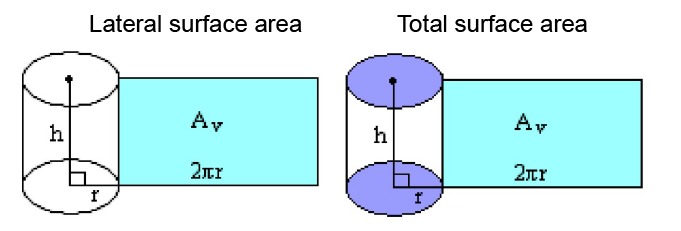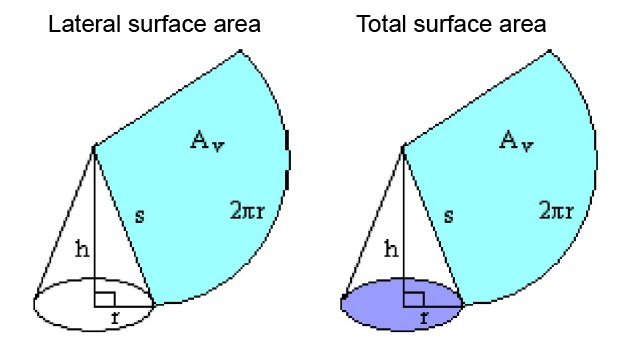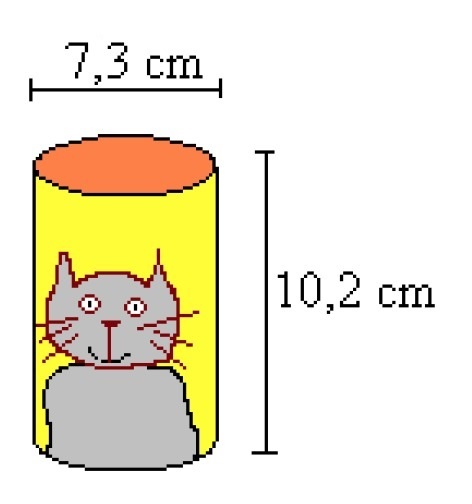8. Areas of different objects
Areas of different objects
The total area of a three-dimensional object consists of the areas of all its parts. The lateral surface area of a three-dimensional object, on the other hand, does not include the areas of the object's bases.
Right polyhedron
Before the area of the lateral surface of a right polyhedron can be calculated, you must first decide which sides of the cube are the bases and which are the walls or surfaces.

The lateral surface area of a rectangular polyhedron is [[$ A_v = ac + bc + ac + bc = 2ac + 2bc. $]].
The total area is [[$ A = A_v + ab + ab = 2ab + 2ac + 2bc = 2(ab + ac + bc) $]].
Circular cylinder

The lateral surface area of a circular cylinder is [[$ A_v = 2 \pi rh $]].
The total area is [[$ A = A_v + 2 \pi r^2 = 2 \pi rh + 2 \pi r^2 = 2 \pi r (h + r) $]].
Circular cone

The lateral surface of a circular cone consists of a circular sector whose arc length is the circumference of the bottom circle ([[$ 2\pi r $]]) and the radius of the bottom circle [[$ s $]].
The lateral surface area of a circular cone is [[$ A_v = \pi rs $]].
The total area is [[$ A = A_v + \pi r^2 = \pi rs +\pi r^2 = \pi r(r + s) $]].
Example 1
Calculate the surface area of the cat food jar. How much sheet metal is needed to make the jar?
Solution:
The area of the lateral surface is
[[$ \begin{align*} A_v &= 2 \pi rh \\ &= 2 \pi \cdot 3,\!65 \; \text {cm} \cdot 10,\!2 \; \text {cm} \\ &≈ 233,\!923 \;\text {cm}^2 \\ &≈ 234 \;\text {cm}^2 \\ \end{align*} $]]
The required amount of sheet metal is indicated by the total area of the jar.
[[$ \begin{align*}
A &= A_v + 2 \pi r \\
&= 233,\!923 \;\text {cm}^2 + 2 \pi \cdot (3,\!65 \;\text {cm})^2 \\
&≈ 318 \;\text {cm}^2 \\
\end{align*} $]]
Answer: The jar has a surface area of [[$ 243 $]] cm [[$ ^ 2 $]] and a total area of [[$ 318 $]] cm [[$ ^ 2 $]].
Note! If the total area of a circular cylinder of a certain volume is desired to be as small as possible, the height of the cylinder must be equal to the diameter of its base. However, in cylindrical metal jars, the height is often [[$ 1,4 $]] times the diameter.
Exercises
Basic exercises
Applied exercises
Challenging exercises
2/08. Submission folder for answers
Sinulla ei ole tarvittavia oikeuksia lähettää mitään.